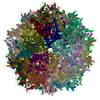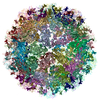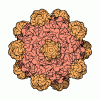+ Open data
Open data
- Basic information
Basic information
| Entry |  | |||||||||
|---|---|---|---|---|---|---|---|---|---|---|
| Title | The capsid structure of Aleutian Mink Disease Virus | |||||||||
 Map data Map data | ||||||||||
 Sample Sample |
| |||||||||
| Function / homology |  Function and homology information Function and homology informationpermeabilization of host organelle membrane involved in viral entry into host cell / symbiont entry into host cell via permeabilization of inner membrane / T=1 icosahedral viral capsid / clathrin-dependent endocytosis of virus by host cell / host cell nucleus / virion attachment to host cell / structural molecule activity Similarity search - Function | |||||||||
| Biological species |   Aleutian mink disease virus Aleutian mink disease virus | |||||||||
| Method |  single particle reconstruction / single particle reconstruction /  cryo EM / Resolution: 2.37 Å cryo EM / Resolution: 2.37 Å | |||||||||
 Authors Authors | Mietzsch M / McKenna R | |||||||||
| Funding support |  United States, 1 items United States, 1 items
| |||||||||
 Citation Citation |  Journal: Viruses / Year: 2022 Journal: Viruses / Year: 2022Title: Capsid Structure of Aleutian Mink Disease Virus and Human Parvovirus 4: New Faces in the Parvovirus Family Portrait. Authors: Renuk Lakshmanan / Mario Mietzsch / Alberto Jimenez Ybargollin / Paul Chipman / Xiaofeng Fu / Jianming Qiu / Maria Söderlund-Venermo / Robert McKenna /   Abstract: Parvoviruses are small, single-stranded DNA viruses with non-enveloped capsids. Determining the capsid structures provides a framework for annotating regions important to the viral life cycle. ...Parvoviruses are small, single-stranded DNA viruses with non-enveloped capsids. Determining the capsid structures provides a framework for annotating regions important to the viral life cycle. Aleutian mink disease virus (AMDV), a pathogen in minks, and human parvovirus 4 (PARV4), infecting humans, are parvoviruses belonging to the genera and , respectively. While Aleutian mink disease caused by AMDV is a major threat to mink farming, no clear clinical manifestations have been established following infection with PARV4 in humans. Here, the capsid structures of AMDV and PARV4 were determined via cryo-electron microscopy at 2.37 and 3.12 Å resolutions, respectively. Despite low amino acid sequence identities (10-30%) both viruses share the icosahedral nature of parvovirus capsids, with 60 viral proteins (VPs) assembling the capsid via two-, three-, and five-fold symmetry VP-related interactions, but display major structural variabilities in the surface loops when the capsid structures are superposed onto other parvoviruses. The capsid structures of AMDV and PARV4 will add to current knowledge of the structural platform for parvoviruses and permit future functional annotation of these viruses, which will help in understanding their infection mechanisms at a molecular level for the development of diagnostics and therapeutics. | |||||||||
| History |
|
- Structure visualization
Structure visualization
| Supplemental images |
|---|
- Downloads & links
Downloads & links
-EMDB archive
| Map data |  emd_28514.map.gz emd_28514.map.gz | 443 MB |  EMDB map data format EMDB map data format | |
|---|---|---|---|---|
| Header (meta data) |  emd-28514-v30.xml emd-28514-v30.xml emd-28514.xml emd-28514.xml | 14.4 KB 14.4 KB | Display Display |  EMDB header EMDB header |
| Images |  emd_28514.png emd_28514.png | 71.7 KB | ||
| Others |  emd_28514_half_map_1.map.gz emd_28514_half_map_1.map.gz emd_28514_half_map_2.map.gz emd_28514_half_map_2.map.gz | 147.6 MB 147.6 MB | ||
| Archive directory |  http://ftp.pdbj.org/pub/emdb/structures/EMD-28514 http://ftp.pdbj.org/pub/emdb/structures/EMD-28514 ftp://ftp.pdbj.org/pub/emdb/structures/EMD-28514 ftp://ftp.pdbj.org/pub/emdb/structures/EMD-28514 | HTTPS FTP |
-Related structure data
| Related structure data |  8ep2MC  8ep9C C: citing same article ( M: atomic model generated by this map |
|---|---|
| Similar structure data | Similarity search - Function & homology  F&H Search F&H Search |
- Links
Links
| EMDB pages |  EMDB (EBI/PDBe) / EMDB (EBI/PDBe) /  EMDataResource EMDataResource |
|---|---|
| Related items in Molecule of the Month |
- Map
Map
| File |  Download / File: emd_28514.map.gz / Format: CCP4 / Size: 476.8 MB / Type: IMAGE STORED AS FLOATING POINT NUMBER (4 BYTES) Download / File: emd_28514.map.gz / Format: CCP4 / Size: 476.8 MB / Type: IMAGE STORED AS FLOATING POINT NUMBER (4 BYTES) | ||||||||||||||||||||
|---|---|---|---|---|---|---|---|---|---|---|---|---|---|---|---|---|---|---|---|---|---|
| Voxel size | X=Y=Z: 0.949 Å | ||||||||||||||||||||
| Density |
| ||||||||||||||||||||
| Symmetry | Space group: 1 | ||||||||||||||||||||
| Details | EMDB XML:
|
-Supplemental data
-Half map: #2
| File | emd_28514_half_map_1.map | ||||||||||||
|---|---|---|---|---|---|---|---|---|---|---|---|---|---|
| Projections & Slices |
| ||||||||||||
| Density Histograms |
-Half map: #1
| File | emd_28514_half_map_2.map | ||||||||||||
|---|---|---|---|---|---|---|---|---|---|---|---|---|---|
| Projections & Slices |
| ||||||||||||
| Density Histograms |
- Sample components
Sample components
-Entire : Aleutian mink disease virus
| Entire | Name:   Aleutian mink disease virus Aleutian mink disease virus |
|---|---|
| Components |
|
-Supramolecule #1: Aleutian mink disease virus
| Supramolecule | Name: Aleutian mink disease virus / type: virus / ID: 1 / Parent: 0 / Macromolecule list: all / NCBI-ID: 28314 / Sci species name: Aleutian mink disease virus / Virus type: VIRUS-LIKE PARTICLE / Virus isolate: STRAIN / Virus enveloped: No / Virus empty: Yes |
|---|---|
| Host system | Organism:   Spodoptera frugiperda (fall armyworm) / Recombinant cell: Sf9 Spodoptera frugiperda (fall armyworm) / Recombinant cell: Sf9 |
| Virus shell | Shell ID: 1 / T number (triangulation number): 1 |
-Macromolecule #1: Capsid protein VP1
| Macromolecule | Name: Capsid protein VP1 / type: protein_or_peptide / ID: 1 / Number of copies: 60 / Enantiomer: LEVO |
|---|---|
| Source (natural) | Organism:   Aleutian mink disease virus Aleutian mink disease virus |
| Molecular weight | Theoretical: 73.595305 KDa |
| Recombinant expression | Organism:   Spodoptera frugiperda (fall armyworm) Spodoptera frugiperda (fall armyworm) |
| Sequence | String: MDSTEAEQMD TEQATNQTAE AGGGGGGGGG GGGGGGGVGN STGGFNNTTE FKVINNEVYI TCHATRMVHI NQADTDEYLI FNAGRTTDT KTHQQKLNLE FFVYDDFHQQ VMTPWYIVDS NAWGVWMSPK DFQQMKTLCS EISLVTLEQE IDNVTIKTVT E TNQGNAST ...String: MDSTEAEQMD TEQATNQTAE AGGGGGGGGG GGGGGGGVGN STGGFNNTTE FKVINNEVYI TCHATRMVHI NQADTDEYLI FNAGRTTDT KTHQQKLNLE FFVYDDFHQQ VMTPWYIVDS NAWGVWMSPK DFQQMKTLCS EISLVTLEQE IDNVTIKTVT E TNQGNAST KQFNNDLTAS LQVALDTNNI LPYTPAAPLG ETLGFVPWRA TKPTQYRYYH PCYIYNRYPN IQKVATETLT WD AVQDDYL SVDEQYFNFI TIENNIPINI LRTGDNFHTG LYEFNSKPCK LTLSYQSTRC LGLPPLCKPK TDTTHKVTSK ENG ADLIYI QGQDNTRLGH FWGEERGKKN AEMNRIRPYN IGYQYPEWII PAGLQGSYFA GGPRQWSDTT KGAGTHSQHL QQNF STRYI YDRNHGGDNE VDLLDGIPIH ERSNYYSDNE IEQHTAKQPK LRTPPIHHSK IDSWEEEGWP AASGTHFEDE VIYLD YFNF SGEQELNFPH EVLDDAAQMK KLLNSYQPTV AQDNVGPVYP WGQIWDKKPH MDHKPSMNNN APFVCKNNPP GQLFVK LTE NLTDTFNYDE NPDRIKTYGY FTWRGKLVLK GKLSQVTCWN PVKRELIGEP GVFTKDKYHK QIPNNKGNFE IGLQYGR ST IKYIY |
-Experimental details
-Structure determination
| Method |  cryo EM cryo EM |
|---|---|
 Processing Processing |  single particle reconstruction single particle reconstruction |
| Aggregation state | particle |
- Sample preparation
Sample preparation
| Buffer | pH: 7.4 |
|---|---|
| Vitrification | Cryogen name: ETHANE |
- Electron microscopy
Electron microscopy
| Microscope | FEI TITAN KRIOS |
|---|---|
| Electron beam | Acceleration voltage: 300 kV / Electron source:  FIELD EMISSION GUN FIELD EMISSION GUN |
| Electron optics | Illumination mode: FLOOD BEAM / Imaging mode: BRIGHT FIELD Bright-field microscopy / Nominal defocus max: 2.0 µm / Nominal defocus min: 0.5 µm Bright-field microscopy / Nominal defocus max: 2.0 µm / Nominal defocus min: 0.5 µm |
| Image recording | Film or detector model: DIRECT ELECTRON APOLLO (4k x 4k) / Average electron dose: 59.0 e/Å2 |
| Experimental equipment |  Model: Titan Krios / Image courtesy: FEI Company |
- Image processing
Image processing
| CTF correction | Software - Name: cisTEM |
|---|---|
| Initial angle assignment | Type: COMMON LINE |
| Final angle assignment | Type: ANGULAR RECONSTITUTION |
| Final reconstruction | Resolution.type: BY AUTHOR / Resolution: 2.37 Å / Resolution method: FSC 0.143 CUT-OFF / Number images used: 93393 |
 Movie
Movie Controller
Controller









 Z
Z Y
Y X
X

















